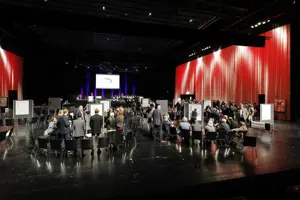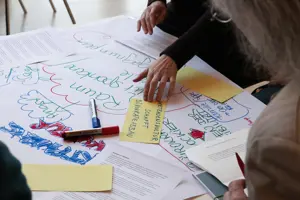Genuine involvement instead of passive input: interactive formats bring events to life
Events are a form of personal encounter. Often the encounter is very one-sided: the presenter presents, the panel discusses, the audience listens more or less intently. How can meetings and congresses be designed in a way that makes them lively? This is a question almost all event organisers ask. It's a question they often ask us, too. A central part of the answer is "by using interactive event formats".
Eva-Maria Feuerstein, project leader of many corporate events and conferences, and Ursula Kaufmann, the first contact for many clients of Kongresskultur Bregenz, have compiled the most important questions and answers.
What is meant by "interactive event formats"? And what formats are there?
Interactive formats add variety to, and change the rules of, events or sections of events. They are born of the experience that lively interaction contributes significantly to an event's success. Well known examples of this type of event format include Open Space, World Café, Fishbowl, Barcamp, Pecha Kucha, Round Table and Walk & Talk. But beyond that there's a vast range of other possibilities.
When should I consider using interactive formats?
Whenever the objective of the event is networking, shared learning, involvement of the participants or their engaging with one another, then interactive formats are worthwhile. In other words, virtually all the time!
What can interactive formats do for me? Where's the benefit and why is participation important?
They offer attendees the chance to get actively involved in the event, and thereby increase the likelihood of new knowledge being generated for everybody taking part in it. That includes sometimes leaving your comfort zone.
The idea is: everyone is to some degree an expert in his or her field. Participants bring their individual expertise to the table and that way they can pass on what they know. They feel appreciated and go home having had a positive experience. The results become better.
"Participation and interaction are important principles in designing events today," states Dr. Lukas Zenk, professor at Danube University Krems, one of the driving forces of micelab:bodensee and a cooperation partner with Kongresskultur Bregenz. The professor conducts extensive research into the effectiveness of new methods. "In this way the participants can articulate their interests and contribute their experiences and values to the collaborative project. By swapping roles, they can themselves become co-creators and experts and contribute content that's relevant to them. And by doing so they take ownership of the project and later take on responsibility for the success of their own tasks and duties," Zenk explains.
Why are interactive formats becoming more and more important?
These days, talks and presentations can be watched at home or at the work place on the Internet more conveniently and at less expense. Bringing people together at a place so they can meet in person, on the other hand, must offer some added value: lively interaction. There therefore needs to be a well-balanced mixture of input by excellent speakers and involvement of the participants.
My event works in the tried and tested way. Why try out something new?
If you achieve your objectives with currently existing means, there's of course no urgent necessity to revamp the concept in a fundamental way. Just think ahead soon enough. How will my participants' needs evolve? What will their expectations be? You are free to adjust your event design gradually, for instance trying out one small innovation every year. That will reinvigorate your event, so it won't be a repetition of the same old thing. Many people can deal with change better if it happens in small steps.
How can I be sure that the participative approach will work?
Trying out participative formats and concepts for yourself will help you gauge how participants will feel. Also the staff of Kongresskultur Bregenz are at your disposal and can share with you many examples of what works well and what you need to bear in mind.
Who can help me with event planning? What do I need to look out for?
Kongresskultur Bregenz offers Event Planning Sprints, in which your event concept will be further developed in a short space of time by a heterogeneous team using design-thinking methods. Through its close association with micelab:bodensee, Kongresskultur additionally can call on a wide network of creative and innovative professionals.
One of the most important principles of the Art of Hosting method is, "Be over-prepared and under-structured." That means intensive preparation guarantees smooth implementation.
Where can I find inspiration on this topic?
In many cases it's possible to attend events held by other organisations at Bregenz Festival House – a kind of sightseeing. We would be happy to arrange that for you. Convention Partner Vorarlberg organises the annual Convention Forum, which is focused on event design and tries out new formats itself. micelab:bodensee also conducts research on the culture of encounter in the MICE industry and welcomes participants. Various event formats are utilised at Convention4u, an annual industry-wide congress organised by the Austrian Convention Bureau. And of course lots of reports and videos about inspiring events can be found on the Internet.
(wp - pzwei)

Open Space – for an open exchange of ideas
Meike Twiehaus, project manager of the EVVC-Management Conference, introduces the Open Space method.
To the open space
People have their say in the World Café
The World Café is a workshop method for 15 to 2,000 people.
To the world cafe
Take your places in the fishbowl!
When congress attendees not only take part but also actively contribute, it occurs thanks to the innovative ideas and expertise of Kongresskultur Bregenz in event organisation, says Urs Treuthardt.
To the fishbowl

